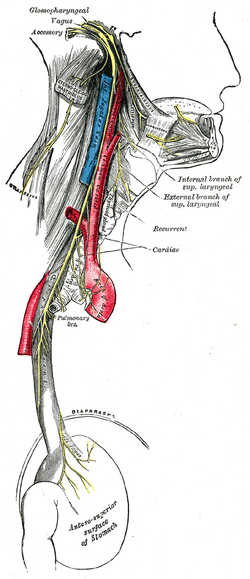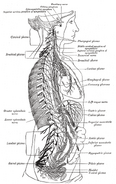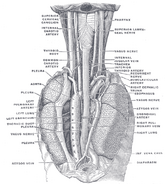(New page: {{BioPsy}} {{Infobox Nerve | Name = {{PAGENAME}} | Latin = nervus laryngeus recurrens | GraySubject = 205 | GrayPage = 912 | Image = Gray622.png | Ca...) |
No edit summary |
||
| Line 22: | Line 22: | ||
It is referred to as "recurrent" because the branches of the nerve innervate the [[Larynx#Muscles|laryngeal muscles]] in the neck through a rather circuitous route: they descend down into the [[thorax]] before rising up between the trachea and esophagus to reach the neck. |
It is referred to as "recurrent" because the branches of the nerve innervate the [[Larynx#Muscles|laryngeal muscles]] in the neck through a rather circuitous route: they descend down into the [[thorax]] before rising up between the trachea and esophagus to reach the neck. |
||
| − | The left branch loops under and around the |
+ | The left branch loops under and around the arch of the aorta before ascending, whereas the right branch loops around the right subclavian artery. |
The nerve splits into anterior and posterior rami before supplying muscles in the voice box — it supplies all laryngeal [[muscle]]s except for the [[cricothyroid muscle|cricothyroid]], which is innervated by the external branch of the [[superior laryngeal nerve]]. |
The nerve splits into anterior and posterior rami before supplying muscles in the voice box — it supplies all laryngeal [[muscle]]s except for the [[cricothyroid muscle|cricothyroid]], which is innervated by the external branch of the [[superior laryngeal nerve]]. |
||
==Clinical significance== |
==Clinical significance== |
||
| − | The nerve is best known for its importance in [[thyroid]] surgery, as it runs immediately posterior to this gland. If it is damaged during surgery, the patient will have a hoarse voice. Nerve damage can be assessed by |
+ | The nerve is best known for its importance in [[thyroid]] surgery, as it runs immediately posterior to this gland. If it is damaged during surgery, the patient will have a hoarse voice. Nerve damage can be assessed by laryngoscopy, during which a [[stroboscope|stroboscopic]] light confirms the absence of movement in the affected side of the vocal cords. |
| − | Similar problems may also be due to invasion of the nerve by a |
+ | Similar problems may also be due to invasion of the nerve by a tumor or after [[trauma]] to the neck. |
* If the damage is ''unilateral'', the patient may present with voice changes including hoarseness. |
* If the damage is ''unilateral'', the patient may present with voice changes including hoarseness. |
||
* ''Bilateral'' nerve damage can result in breathing difficulties and [[aphonia]], the inability to speak. |
* ''Bilateral'' nerve damage can result in breathing difficulties and [[aphonia]], the inability to speak. |
||
| Line 35: | Line 35: | ||
==History== |
==History== |
||
| − | + | Galen is said to have first described the clinical syndrome of recurrent laryngeal nerve paralysis. |
|
| − | ==Veterinary medicine== |
||
| − | In [[Veterinary]] medicine, 'roars' refers to a deficit in the left recurrent laryngeal nerve causing characteristic stenuous sounds upon inspiration. |
||
| − | It is treatable by specialists in [[equine]] medicine. |
||
==Additional images== |
==Additional images== |
||
| Line 55: | Line 52: | ||
[[Category:Peripheral nervous system]] |
[[Category:Peripheral nervous system]] |
||
| − | + | :fr:Nerf laryngé récurrent |
|
{{Cranial nerves}} |
{{Cranial nerves}} |
||
Revision as of 09:10, 20 April 2007
Assessment |
Biopsychology |
Comparative |
Cognitive |
Developmental |
Language |
Individual differences |
Personality |
Philosophy |
Social |
Methods |
Statistics |
Clinical |
Educational |
Industrial |
Professional items |
World psychology |
Biological: Behavioural genetics · Evolutionary psychology · Neuroanatomy · Neurochemistry · Neuroendocrinology · Neuroscience · Psychoneuroimmunology · Physiological Psychology · Psychopharmacology (Index, Outline)
| Nerve: Recurrent laryngeal nerve | ||
|---|---|---|
| POSTERIOR VIEW: The tracheobronchial lymph glands (I. and E. Recurrent nerves visible at top.) | ||
| Course and distribution of the glossopharyngeal, vagus, and accessory nerves. | ||
| Latin | nervus laryngeus recurrens | |
| Gray's | subject #205 912 | |
| Innervates | larynx posterior cricoarytenoid lateral cricoarytenoid arytenoid thyroarytenoid | |
| From | vagus nerve | |
| To | ||
| MeSH | [1] | |
The recurrent laryngeal nerve is a branch of the vagus nerve (the tenth cranial nerve) that supplies motor function and sensation to the larynx (voice box).
Path
It is referred to as "recurrent" because the branches of the nerve innervate the laryngeal muscles in the neck through a rather circuitous route: they descend down into the thorax before rising up between the trachea and esophagus to reach the neck.
The left branch loops under and around the arch of the aorta before ascending, whereas the right branch loops around the right subclavian artery.
The nerve splits into anterior and posterior rami before supplying muscles in the voice box — it supplies all laryngeal muscles except for the cricothyroid, which is innervated by the external branch of the superior laryngeal nerve.
Clinical significance
The nerve is best known for its importance in thyroid surgery, as it runs immediately posterior to this gland. If it is damaged during surgery, the patient will have a hoarse voice. Nerve damage can be assessed by laryngoscopy, during which a stroboscopic light confirms the absence of movement in the affected side of the vocal cords.
Similar problems may also be due to invasion of the nerve by a tumor or after trauma to the neck.
- If the damage is unilateral, the patient may present with voice changes including hoarseness.
- Bilateral nerve damage can result in breathing difficulties and aphonia, the inability to speak.
- The right recurrent laryngeal nerve is more susceptible to damage during thyroid surgery due to its relatively medial location.
History
Galen is said to have first described the clinical syndrome of recurrent laryngeal nerve paralysis.
Additional images
External links
- GPnotebook 369492028
- SUNY Figs 21:04-01
- Norman/Georgetown cranialnerves (X)
- Example of Vocal Cord Paralysis on VoiceInfo.org
- fr:Nerf laryngé récurrent
I-IV: olfactory - optic - oculomotor - trochlear
V: trigeminal: trigeminal ganglion
V1: ophthalmic: lacrimal - frontal (supratrochlear, supraorbital) - nasociliary (long root of ciliary, long ciliary, infratrochlear, posterior ethmoidal, anterior ethmoidal) - ciliary ganglion (short ciliary)
V2: maxillary: middle meningeal - in the pterygopalatine fossa (zygomatic, zygomaticotemporal, zygomaticofacial, sphenopalatine, posterior superior alveolar)
in the infraorbital canal/infraorbital nerve (middle superior alveolar, anterior superior alveolar)
on the face (inferior palpebral, external nasal, superior labial, infraorbital plexus) - pterygopalatine ganglion (deep petrosal, nerve of pterygoid canal)
branches of distribution (palatine, nasopalatine, pharyngeal)
V3: mandibular: nervus spinosus - medial pterygoid - anterior (masseteric, deep temporal, buccal, lateral pterygoid)
posterior (auriculotemporal, lingual, inferior alveolar, mylohyoid, mental) - otic ganglion - submandibular ganglion
VI: abducens
VII: facial: nervus intermedius - geniculate - inside facial canal (greater petrosal, nerve to the stapedius, chorda tympani)
at exit from stylomastoid foramen (posterior auricular, digastric - stylohyoid)
on face (temporal, zygomatic, buccal, mandibular, cervical)
VIII: vestibulocochlear: cochlear (striae medullares, lateral lemniscus) - vestibular
IX: glossopharyngeal: fasciculus solitarius - nucleus ambiguus - ganglia (superior, petrous) - tympanic - carotid sinus
X: vagus: ganglia (jugular, nodose) - Alderman's nerve - in the neck (pharyngeal branch, superior laryngeal ext and int, recurrent laryngeal)
in the thorax (pulmonary branches, esophageal plexus) - in the abdomen (gastric plexuses, celiac plexus, gastric plexus)
XI: accessory XII: hypoglossal
| This page uses Creative Commons Licensed content from Wikipedia (view authors). |



